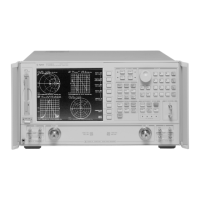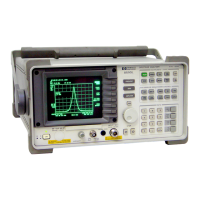3-4
Front/Rear Panel
Front Panel Features
9. The ENTRY block. This block includes the knob, the step
keys, the number pad, and the backspace key. These allow you to enter
numerical data and control the markers.
You can use the numeric keypad to select digits, decimal points, and a
minus sign for numerical entries. You must also select a units terminator
to complete value inputs.
The backspace key has two independent functions: it modifies entries, and
it turns off the softkey menu so that marker information can be moved off
of the grids and into the softkey menu area. For more details, refer to the
“Making Measurements” chapter in the user’s guide.
10. INSTRUMENT STATE function block. These keys allow you to control
channel-independent system functions such as the following:
• copying, save/recall, and GPIB controller mode
• limit testing
• external source mode
• tuned receiver mode
• frequency offset mode
• test sequence function
• harmonic measurements (Option 002)
• time domain transform (Option 010)
GPIB STATUS indicators are also included in this block.
11. key. This key returns the instrument to either a known factory
preset state, or a user preset state that can be defined. Refer to Chapter 8 ,
“Preset State and Memory Allocation,” for a complete listing of the
instrument preset condition.
12. PROBE POWER connectors. These connector (fused inside the
instrument) supply power to an active probe for in-circuit measurements
of ac circuits.
13. R CHANNEL connectors. These connectors allow you to apply an input
signal to the analyzer's R channel, for frequency offset mode.
14. (ES) PORT 1 and PORT 2. These ports output a signal from the source and
receive input signals from a device under test. PORT 1 allows you to
measure S
12
and S
11
. PORT 2 allows you to measure S
21
and S
22
.
14. (ET) REFLECTION and TRANSMISSION ports. The REFLECTION port
outputs a signal from the source and allows you to make reflection
measurements. The TRANSMISSION port receives input signals from a
device under test and allows you to make transmission measurements.
Preset

